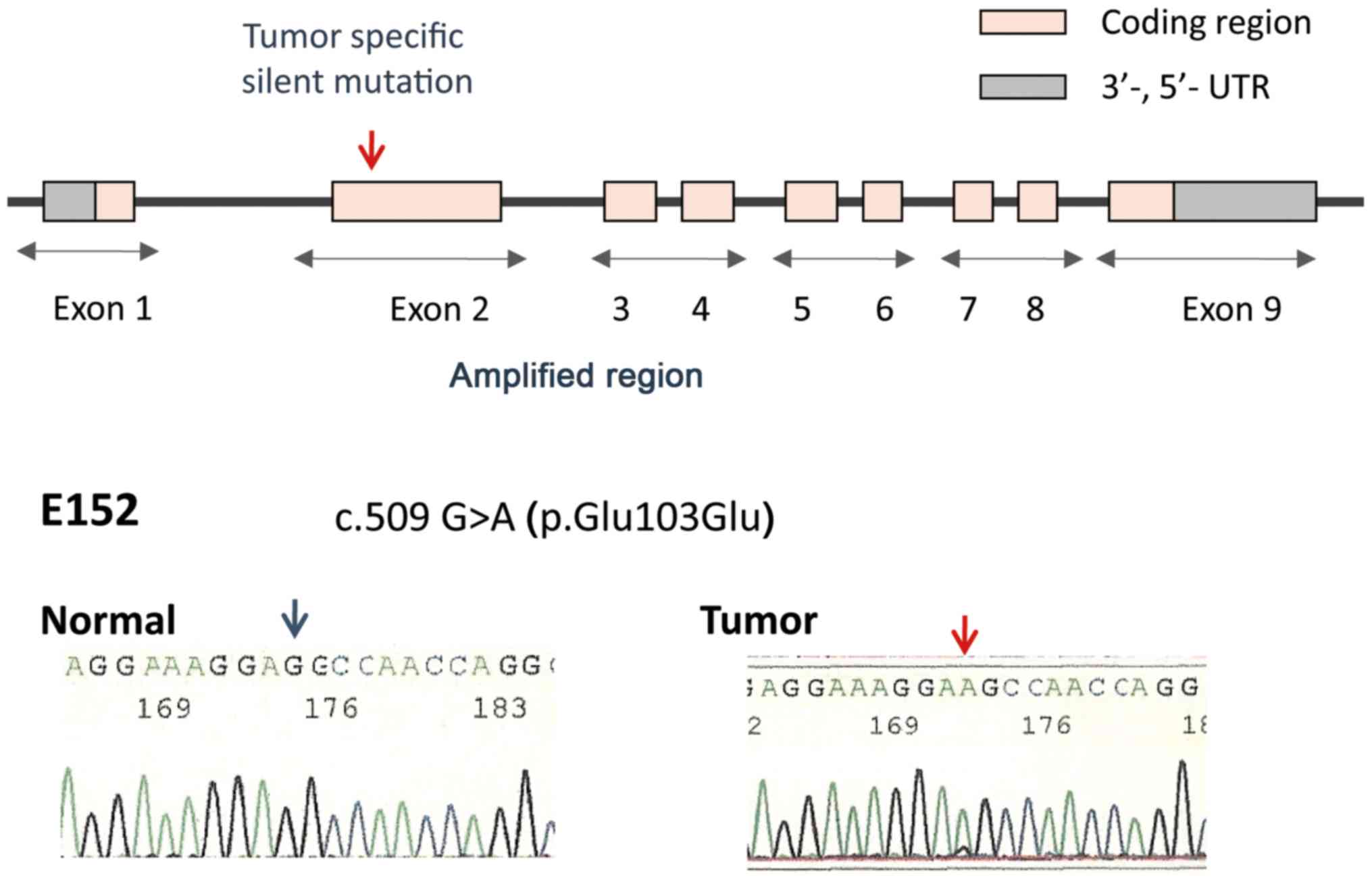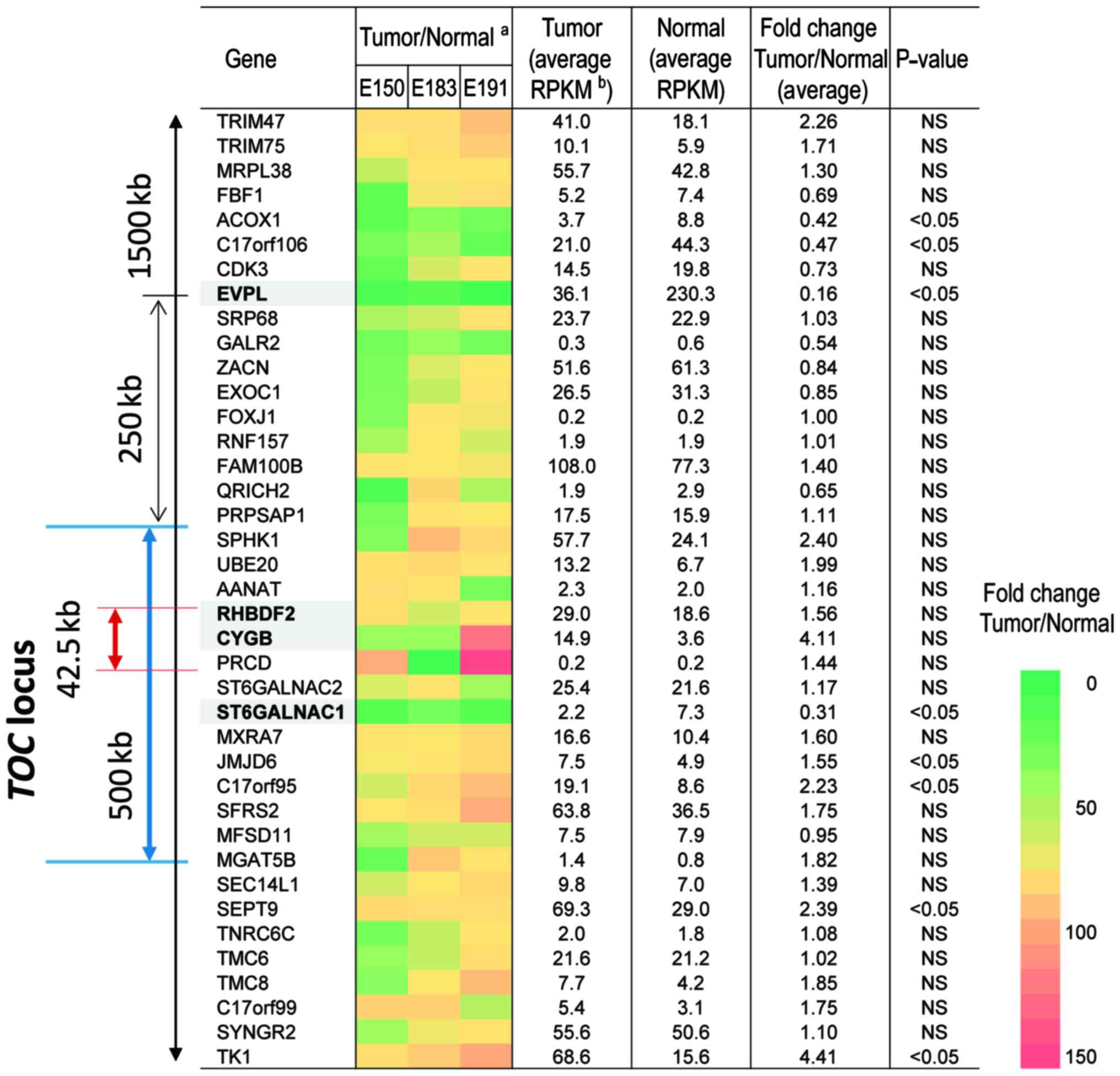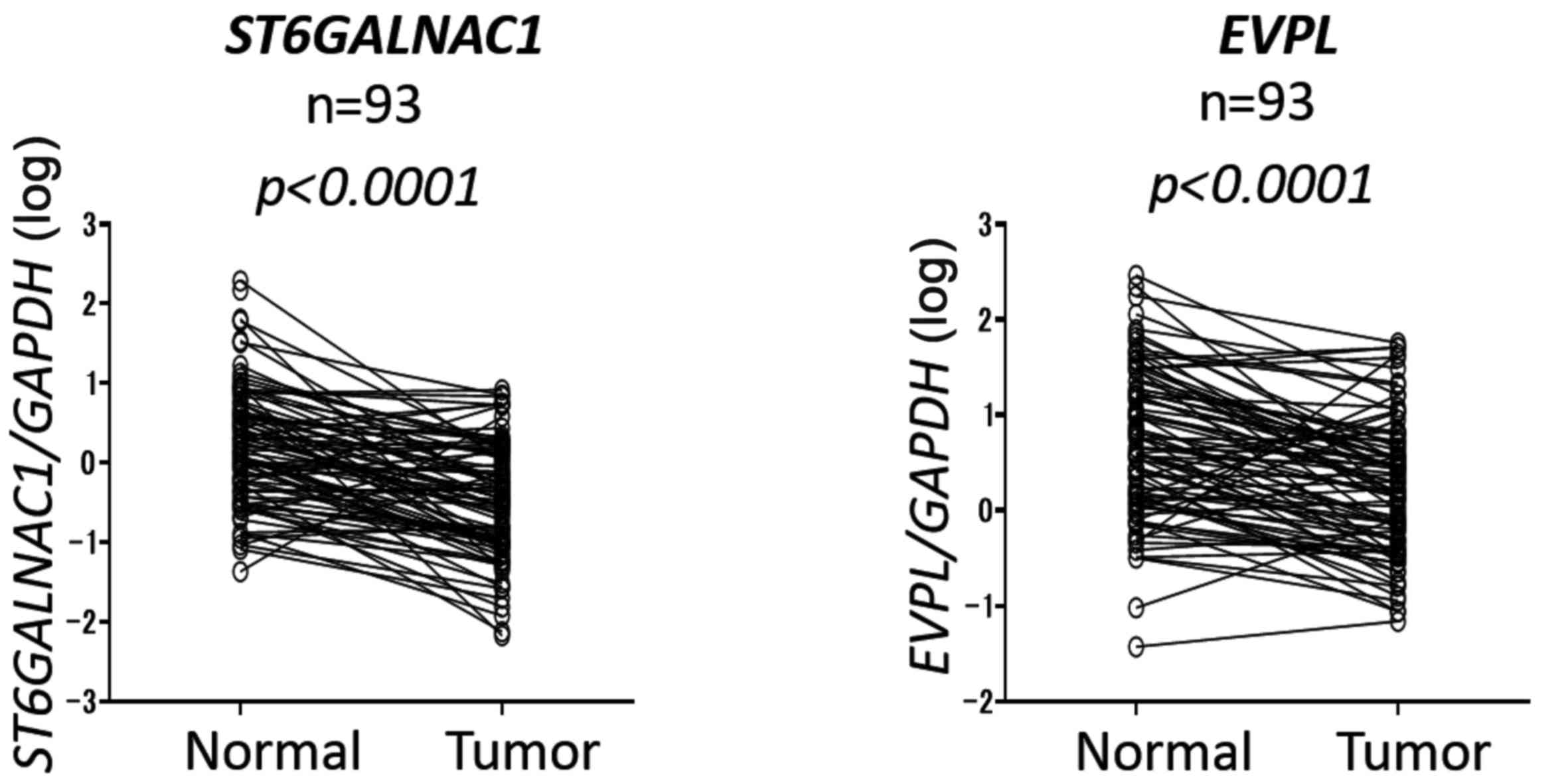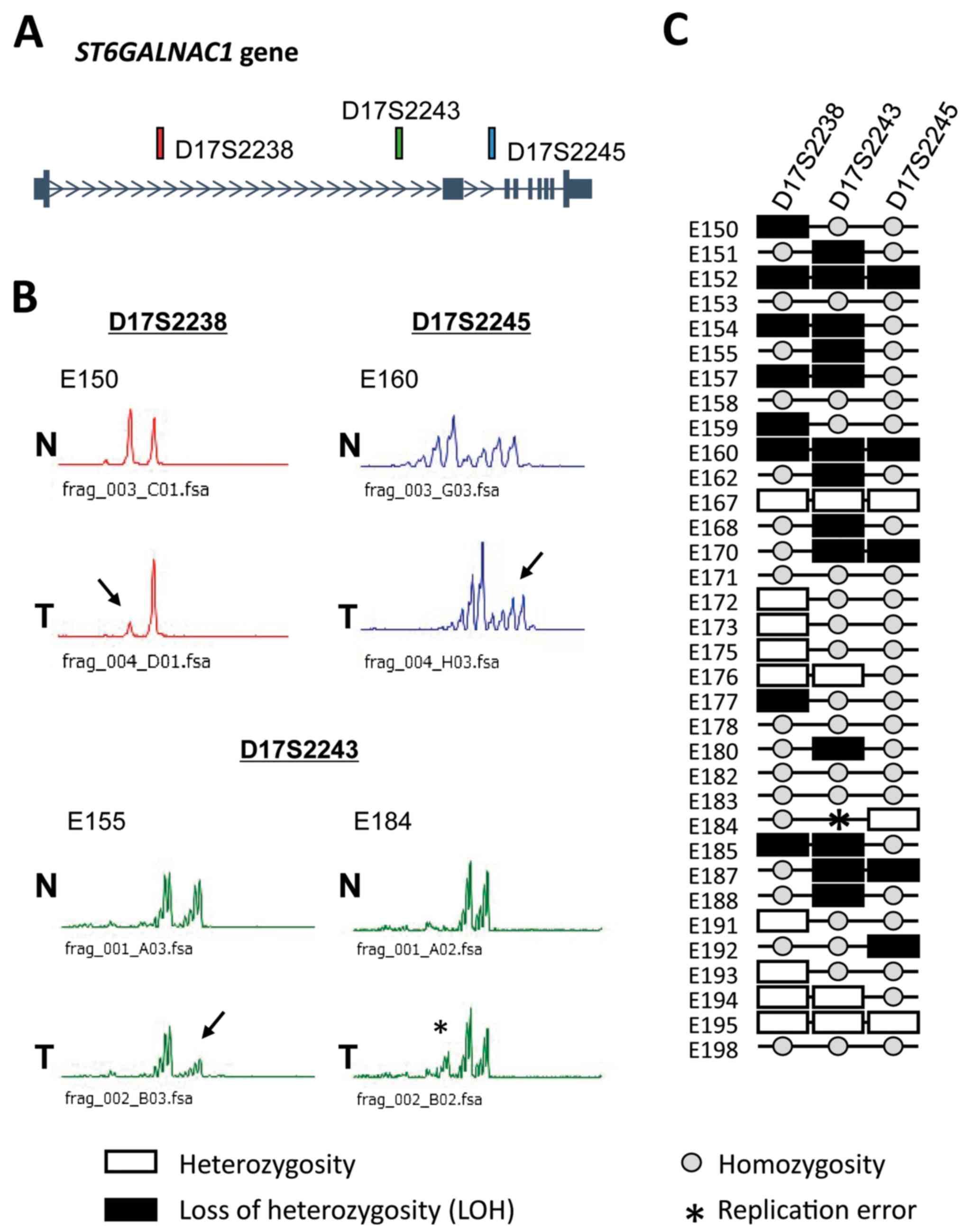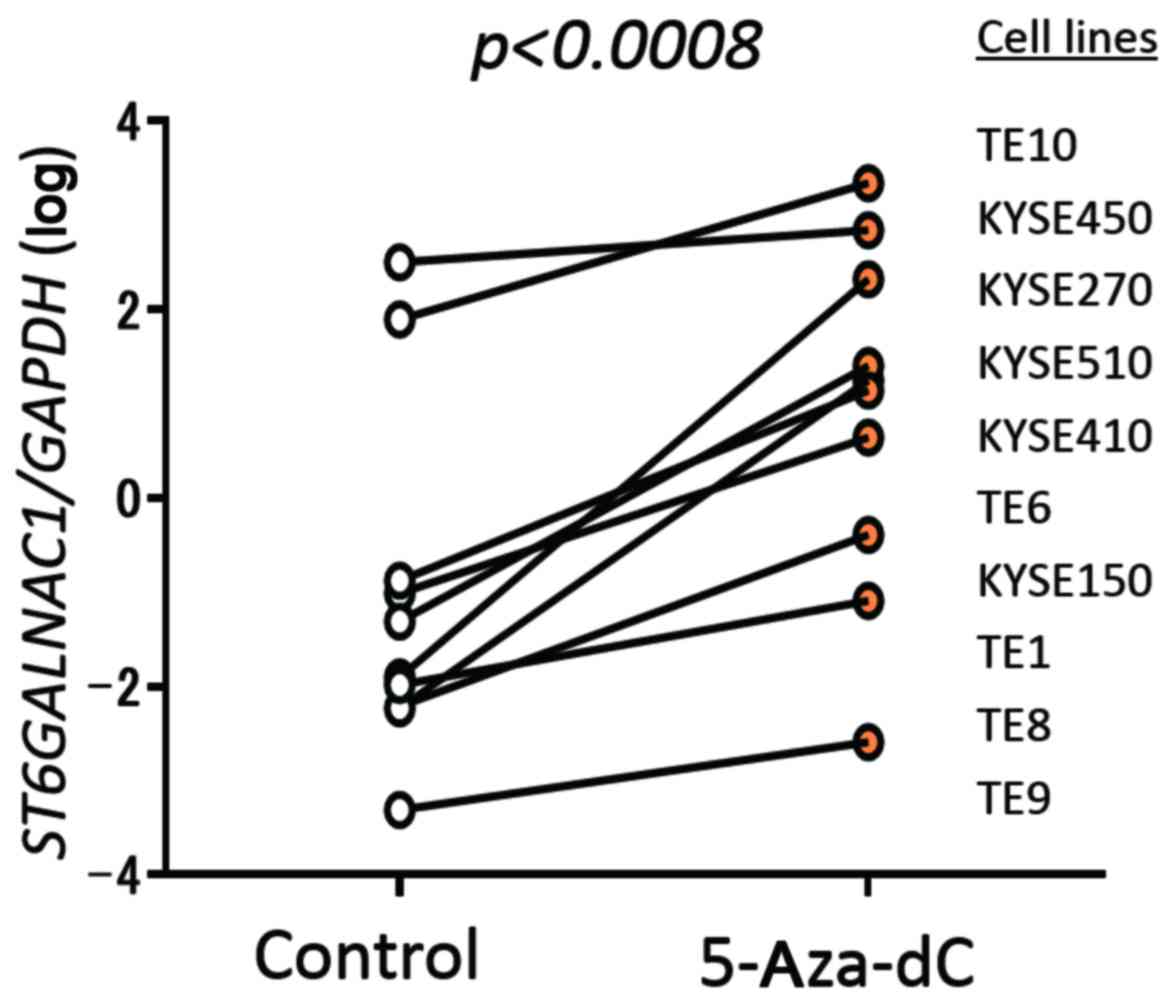Downregulation of ST6GALNAC1 is associated with esophageal squamous cell carcinoma development
- Authors:
- Published online on: December 22, 2016 https://doi.org/10.3892/ijo.2016.3817
- Pages: 441-447
Abstract
Introduction
Tylosis is an extremely rare autosomal, dominantly inherited disorder characterized by abnormal thickening of the palmoplantar skin and a highly elevated risk of esophageal squamous cell carcinoma (ESCC). Five families with high frequencies of tylosis have been reported from the UK, USA, Germany, Spain and Finland (1–7). Linkage and haplotype analyses in these families have localized the tylosis esophageal cancer (TOC) gene locus to a region of chromosome 17q25 (3–5,8,9). It has also been reported that frequent loss of heterozygosity (LOH) in 17q25.1 was observed in the sporadic form of ESCC (10,11). These reports on inherited and sporadic ESCC indicated the presence of a putative tumor suppressor gene for ESCC at this locus. Although abnormalities of genes on 17q25.1, such as CYGB and RHBDF2, have been demonstrated in families with tylosis, abnormalities of these genes have not been clearly demonstrated in sporadic forms of ESCC (12,13). Therefore, additional genes on 17q25.1 other than CYGB and RHBDF2 may also be involved in ESCC development.
Additionally, we recently reported the result of whole-exome sequencing of paired DNA samples from 144 Japanese patients with ESCC (14). The most frequently mutated gene was TP53 (mutated in 93.1% of patients), followed by NOTCH1, MLL2, NFE2L2, ZNF750, FAT1 and PIK3CA (mutated in 10–20% of patients), in line with the results of next-generation sequencing analysis in other studies of sporadic ESCC (14–17). Although 17,189 non-synonymous mutations in 10,552 genes were identified in 144 ESCC samples in our previous study, recurrent mutations were not observed in genes on chromosome 17q25.1, including RHBDF2 (14). Other studies did not uncover RHBDF2 mutations either in sporadic ESCC (16,17).
In this study, we investigated the expression patterns of genes in an ~1500 kb region on 17q25.1, including the TOC locus, in tumor and corresponding normal tissues using RNA sequence (RNA-seq) analysis data from patients with sporadic ESCC. We demonstrated frequent downregulation of ST6 N-acetylgalactosaminide α-2,6-sialyltransferase 1 (ST6GALNAC1) on 17q25.1 in ESCC tissues compared to its expression in corresponding normal tissues.
Patients and methods
Patients and sample collection
A total of 93 ESCC samples obtained by surgery were used after obtaining written informed consent. All patients underwent resection of the primary tumor at Iwate Medical University, Kyushu University Beppu Hospital and affiliated hospitals between 1992 and 2007. Resected cancer and corresponding normal tissues were immediately cut and stored at −80°C until DNA/RNA extraction. Total RNA and DNA were obtained using an RNeasy mini kit and QIAamp DNA mini kit (Qiagen Inc., Valencia, CA, USA), respectively.
Gene expression profiling on chromosome 17q25.1 using RNA-seq data of samples from three patients with ESCC
The expression patterns of genes on chromosome 17q25.1 were analyzed using RNA-seq data for tumor and corresponding normal tissues from three patients with ESCC. The characteristics of the three patients were as follows: well-differentiated SCC in the cervical esophagus (female, 70 years old, T1N0M0, stage I), poorly differentiated SCC in the middle thoracic esophagus (male, 73 years old, T3N0M0, stage II) and moderately differentiated SCC in the lower thoracic esophagus (male, 68 years old, T3N1M0, stage III). One microgram of extracted RNA was used as a template to construct RNA-seq libraries. Detailed protocols of RNA-seq analysis were described previously (18). Fold enrichment of the RNA-seq tags in the samples was calculated for each mRNA using the assigned tag counts and normalized to reads per kilobase (kb) mRNA.
Evaluation of ST6GALNAC1 and EVPL expression in clinical samples
Quantitative real-time reverse transcription-PCR (qRT-PCR) was performed to measure ST6GALNAC1, EVPL, CYGB and glyceraldehyde 3-phosphate dehydrogenase (GAPDH) mRNA expression using a LightCycler 480 Probes Master kit (Roche Applied Science, Mannheim, Germany) according to the manufacturer's protocol with specific primers and universal probes that were designed at the Universal Probe Library's assay design center (http://lifescience.roche.com/shop/CategoryDisplay?catalogId=10001&tab=Assay+Design+Center&identifier=Universal+Probe+Library&langId=-1). Gene expression levels were normalized with respect to those of GAPDH. Primer sequences and universal probe number for each gene are listed in Table I.
Direct sequencing analysis of ST6GALNAC1
In 46 cases of ESCC, coding exons of ST6GALNAC1 were amplified using KOD FX (Toyobo, Tokyo, Japan) according to the manufacturer's protocol and sequenced using BigDye Terminator version 3.1 (Applied Biosystems, Foster City, CA, USA) as previously described (19). Primer sequences are listed in Table II and Fig. 1.
Microsatellite LOH analysis of the ST6GALNAC1 locus
In samples from 34 patients with ESCC, PCR was performed for three dinucleotide repeat microsatellite markers (D17S2238, D17S2243 and D17S2245) within the ST6GALNAC1 locus using fluorescent primer pairs (Applied Biosystems). LOH was analyzed using an ABI PRISM 3100 Genetic Analyzer and GeneScan Analysis and Genotyper software version 3.7.1 (Applied Biosystems).
Cell lines and cell culture
Ten human ESCC cell lines (KY150, KY270, KYSE410, KYSE450, KYSE510, TE1, TE6, TE8, TE9 and TE10) were purchased from the Japanese Collection of Research Bioresources Cell Bank and the Riken Bioresource Center. Cells were maintained in RPMI-1640 containing 10% fetal bovine serum and cultured in a humidified 5% CO2 incubator at 37°C.
Methylation levels and response to 5-aza-2′-deoxycytidine (5-Aza-dC) treatment in ESCC cell lines
ESCC cells were seeded at a density of 1×106 cells/10 cm dish and cultured for 24 h with an inhibitor of DNA methyltransferase, 5-Aza-dC (Sigma-Aldrich, St. Louis, MO, USA), at a final concentration of 2 µM. Control cells were treated with the diluent phosphate-buffered saline (PBS) alone. After 48 h of incubation, total RNA was extracted from collected cells in each dish.
Statistical analysis
Data from RNA-seq analyses, qRT-PCR and methylation assays were analyzed using JMP 12 software (SAS Institute, Inc., Cary, NC, USA) and GraphPad Prism 6 (GraphPad Software Inc., La Jolla, CA, USA). Differences between the gene expression levels of samples were estimated using the Wilcoxon rank test or paired t-test. All differences were considered statistically significant at the level of p<0.05.
Results
Differential gene expression profiling on chromosome 17q25.1 in ESCC samples by RNA-seq analysis
In our RNA-seq analysis from three patients with ESCC with differences in tumor stage, histological differentiation and tumor location, 17,673 genes were detected with an RPKM value of at least 2.0 in either normal or tumor tissues. The first 10 genes showed significant increase or decrease in their expression in tumor tissues compared with their expression in normal tissues and are listed in Table III. Among the expression data obtained by RNA-seq analysis, we focused on the expression profile of genes in a 1500 kb region on 17q25.1 including the TOC locus, which has been mapped to the 500 kb region in UK, USA and German pedigrees (8) and narrowed to a 42.5 kb region in the UK pedigree (9). The differences in expression levels between normal and tumor samples for 39 genes in the region are shown in Fig. 2. Among these genes, the expression levels of EVPL and ST6GALNAC1 in tumor tissues were significantly decreased to less than one-third of the levels in normal tissues (Fig. 2).
Downregulation of ST6GALNAC1 and EVPL in ESCC tissues
We validated the expression levels of these two genes using qRT-PCR in samples from 93 patients with ESCC. Both EVPL and ST6GALNAC1 displayed significant downregulation in tumor samples compared to their corresponding normal tissue levels (p<0.0001) (Fig. 3). Although downregulation of CYGB has been demonstrated in esophageal tissues in tylotic patients compared with that in the normal esophagus (12), a significant difference in its expression was not observed between sporadic ESCC and normal samples by qRT-PCR analyses in our series (data not shown).
Nucleotide variants in ST6GALNAC1
Direct sequence analyses of samples from 46 patients with ESCC revealed several nucleotide variants in ST6GALNAC1. Two missense variants [c. 400 C>T (p.Pro67Leu) and c.724 C>T (p.Thr175Met)] were observed in two patients. In four patients, 3 bp in-frame deletions [c.752_754delTGG (p.His184del)] were observed. These variants were detected in both tumor and corresponding normal tissues, and they have been registered in dbSNP as rs143927446, rs138569950 and rs565363235. A one-base G insertion in intron 3 registered as rs146144287 in dbSNP was also detected in both tumor and normal tissues from six patients with ESCC. Only one patient (1/46, 2.1%) displayed a tumor-specific mutation in exon 2 of ST6GANAC1, although this mutation was silent [c.509 G>A (p.Glu103Glu)] (Fig. 1). Therefore, no tumor-specific non-synonymous mutations were observed in the coding region of ST6GALNAC1.
Frequent LOH was observed in the ST6GALNAC1 locus in ESCC samples
Three microsatellite markers, D17S2238, D17S2243 and D17S2245, were located in the introns of ST6GALNAC1 (Fig. 4A). PCR microsatellite analysis of the ST6GALNAC1 locus in 34 patients using these three markers demonstrated LOH in 17/27 (62.9%) informative cases at one or more sites and a replication error in 1/27 (3.7%) cases at D17S2243 (Fig. 4B and C).
ST6GALNAC1 downregulation by methylation in ESCC cell lines
Treatment with 5-Aza-dC significantly elevated ST6GALNAC1 expression compared to the control level in all 10 ESCC cell lines assessed (Fig. 5).
Discussion
Because the region in chromosome 17q25.1 was affected in both hereditary and sporadic forms of ESCC, it is believed that a gene responsible for the oncogenesis or development of ESCC existed in this region. Several genes in the TOC locus have been studied in inherited and sporadic forms of ESCC. In our present study, ST6GALNAC1 expression was significantly decreased in ESCC tumor tissue compared with that in the corresponding normal tissue, and the gene was located in the vicinity of the minimal region of the TOC locus (Figs. 2 and 3). It was reported that ST6GALNAC1 was associated with biosynthesis of the sialyl-Tn (sTn) antigen in cancer cells and that it was overexpressed in gastric, breast and prostate cancer cell lines, inducing sTn expression (20). In contrast to these findings, our results suggest that ST6GALNAC1 may have a tumor-suppressor function in ESCC. In terms of the downregulation mechanisms of ST6GALNAC1 expression, frequent LOH (62.9%) of the gene locus was demonstrated in ESCC, although no tumor-specific mutation was observed in the coding region (Figs. 1 and 4). Furthermore, demethylation using 5-Aza-dC recovered ST6GALNAC1 expression in all 10 ESCC cell lines examined (Fig. 5). There are no CpG islands in the promoter region of ST6GALNAC1. However, it has been reported that ST6GALNAC1 was downregulated by hyper-methylation of GC 2 bp upstream of the transcription start site in estrogen receptor- and progesterone receptor-positive breast cancers (21). These results suggest that ST6GALNAC1 was inactivated by LOH and hyper-methylation of the transcription start site.
Several candidate genes for sporadic and inherited ESCC have been demonstrated. EVPL is a member of the desmosomal plaque protein family that attaches to desmosomal cadherin and keratin filaments. We previously reported infrequent mutations and frequent LOH of this gene in sporadic ESCC (22). In this study, we demonstrated that EVPL expression was significantly decreased in ESCC tissues (Fig. 3). Downregulation of EVPL may be involved in ESCC development, although the gene is located 250 kb to the telomeric side of the minimal region of the TOC locus (Fig. 2). It has been demonstrated that CYGB was a tumor suppressor gene inactivated by DNA hyper-methylation of its promoter in several types of cancer, including ESCC (12,23). However, downregulation of CYGB was not observed in our series of tumor tissues from Japanese patients with ESCC compared to its levels in the corresponding normal tissues (data not shown). CYGB methylation has also been demonstrated in multiple malignancies other than ESCC, such as leukaemia as well as breast, bladder, lung and colon cancers (23). These findings indicated that alterations of CYGB were limited to a subset of ESCCs and that the tumor-suppressor role of CYGB may not be specific in esophageal tissues but instead may be common among many types of malignancies.
Recently, missense mutations of RHBDF2 in the minimal region of the TOC locus were identified in patients with tylosis from US/UK, German and Finnish families (7,13). It may be clear that RHBDF2 is a responsible gene for tylosis. Blaydon et al demonstrated that the altered RHBDF2 represents a gain-of-function allele that results in sustained EGFR signaling within the cells, and the signaling leads to a hyper-proliferative phenotype. Furthermore, it was suggested that RHBDF2 may also be dysregulated in a similar manner in sporadic ESCC according to immunohistochemical data (13). In our previous study, however, RHBDF2 mutation was not observed by whole-exome sequence analysis using next-generation sequencing in 144 patients with sporadic ESCC (14). This sequencing analysis also demonstrated that recurrent mutations were observed only in ZNF750, with the mutation rate of 16.7%, on chromosome 17q. Frequent ZNF750 mutations were also demonstrated in Chinese patients with sporadic ESCC by whole-exome sequence analysis (15). Furthermore, we found that the mutational APOBEC signature was predominantly observed in the ESCC genome, and ZNF750 mutations were positively associated with the APOBEC signature (14). ZNF750 was located on 17q25.3 telomeric to the TOC locus, and its mutations were null mutations accompanied by LOH (14). Therefore, ZNF750 may be a strong candidate tumor suppressor gene for ESCC. It remains unclear as to which gene dysregulation of in the chromosomal region is essential for the development of hereditary and sporadic forms of ESCC. Mutations in one allele of RHBDF2 gene induced sustained EGFR signaling in the cells and led to a hyperproliferative phenotype during wound repair in patients with tylosis (13). Although RHBDF2 mutation was not observed in sporadic ESCC, the EGFR signaling were frequently dysregulated in sporadic ESCC cells (14–17). Therefore, an abnormality in the RHBDF2-EGFR pathway may lead to precancerous lesions in the esophagus. In addition to the oncogenic change in RHBDF2-EGFR, further inactivation of several tumor suppressor genes on 17q25, such as EVPL, CYGB and ZNF750, by a two-hit mechanism may induce ESCC.
In conclusion, ST6GALNAC1 was downregulated in sporadic ESCC by hyper-methylation and LOH, and it may be a candidate responsible gene for ESCC. Furthermore, our results on sporadic ESCC and recent studies on tylotic families suggest that multiple genes on chromosome 17q25 are involved in ESCC development (Table IV).
Table IVSummary of altered genes on chromosome 17q25 in sporadic or hereditary forms of esophageal squamous cell carcinoma (ESCC). |
Acknowledgments
This study was supported by JSPS KAKENHI (grant nos. JP23591937 and JP26461994).
References
|
Ellis A, Field JK, Field EA, Friedmann PS, Fryer A, Howard P, Leigh IM, Risk J, Shaw JM and Whittaker J: Tylosis associated with carcinoma of the oesophagus and oral leukoplakia in a large Liverpool family - a review of six generations. Eur J Cancer B Oral Oncol. 30B:102–112. 1994. View Article : Google Scholar | |
|
Stevens HP, Kelsell DP, Bryant SP, Bishop DT, Spurr NK, Weissenbach J, Marger D, Marger RS and Leigh IM: Linkage of an American pedigree with palmoplantar keratoderma and malignancy (palmoplantar ectodermal dysplasia type III) to 17q24. Literature survey and proposed updated classification of the keratodermas. Arch Dermatol. 132:640–651. 1996. View Article : Google Scholar : PubMed/NCBI | |
|
Hennies HC, Hagedorn M and Reis A: Palmoplantar keratoderma in association with carcinoma of the esophagus maps to chromosome 17q distal to the keratin gene cluster. Genomics. 29:537–540. 1995. View Article : Google Scholar : PubMed/NCBI | |
|
Kelsell DP, Risk JM, Leigh IM, Stevens HP, Ellis A, Hennies HC, Reis A, Weissenbach J, Bishop DT, Spurr NK, et al: Close mapping of the focal non-epidermolytic palmoplantar keratoderma (PPK) locus associated with oesophageal cancer (TOC). Hum Mol Genet. 5:857–860. 1996. View Article : Google Scholar : PubMed/NCBI | |
|
Risk JM, Field EA, Field JK, Whittaker J, Fryer A, Ellis A, Shaw JM, Friedmann PS, Bishop DT, Bodmer J, et al: Tylosis oesophageal cancer mapped. Nat Genet. 8:319–321. 1994. View Article : Google Scholar : PubMed/NCBI | |
|
Varela AB, Blanco Rodríguez MM, Boullosa PE and Silva JG: Tylosis A with squamous cell carcinoma of the oesophagus in a Spanish family. Eur J Gastroenterol Hepatol. 23:286–288. 2011. View Article : Google Scholar : PubMed/NCBI | |
|
Saarinen S, Vahteristo P, Lehtonen R, Aittomäki K, Launonen V, Kiviluoto T and Aaltonen LA: Analysis of a Finnish family confirms RHBDF2 mutations as the underlying factor in tylosis with esophageal cancer. Fam Cancer. 11:525–528. 2012. View Article : Google Scholar : PubMed/NCBI | |
|
Risk JM, Evans KE, Jones J, Langan JE, Rowbottom L, McRonald FE, Mills HS, Ellis A, Shaw JM, Leigh IM, et al: Characterization of a 500 kb region on 17q25 and the exclusion of candidate genes as the familial tylosis oesophageal cancer (TOC) locus. Oncogene. 21:6395–6402. 2002. View Article : Google Scholar : PubMed/NCBI | |
|
Langan JE, Cole CG, Huckle EJ, Byrne S, McRonald FE, Rowbottom L, Ellis A, Shaw JM, Leigh IM, Kelsell DP, et al: Novel microsatellite markers and single nucleotide polymorphisms refine the tylosis with oesophageal cancer (TOC) minimal region on 17q25 to 42.5 kb: Sequencing does not identify the causative gene. Hum Genet. 114:534–540. 2004. View Article : Google Scholar : PubMed/NCBI | |
|
Iwaya T, Maesawa C, Ogasawara S and Tamura G: Tylosis esophageal cancer locus on chromosome 17q25.1 is commonly deleted in sporadic human esophageal cancer. Gastroenterology. 114:1206–1210. 1998. View Article : Google Scholar : PubMed/NCBI | |
|
von Brevern M, Hollstein MC, Risk JM, Garde J, Bennett WP, Harris CC, Muehlbauer KR and Field JK: Loss of heterozygosity in sporadic oesophageal tumors in the tylosis oesophageal cancer (TOC) gene region of chromosome 17q. Oncogene. 17:2101–2105. 1998. View Article : Google Scholar : PubMed/NCBI | |
|
McRonald FE, Liloglou T, Xinarianos G, Hill L, Rowbottom L, Langan JE, Ellis A, Shaw JM, Field JK and Risk JM: Downregulation of the cytoglobin gene, located on 17q25, in tylosis with oesophageal cancer (TOC): Evidence for trans-allele repression. Hum Mol Genet. 15:1271–1277. 2006. View Article : Google Scholar : PubMed/NCBI | |
|
Blaydon DC, Etheridge SL, Risk JM, Hennies HC, Gay LJ, Carroll R, Plagnol V, McRonald FE, Stevens HP, Spurr NK, et al: RHBDF2 mutations are associated with tylosis, a familial esophageal cancer syndrome. Am J Hum Genet. 90:340–346. 2012. View Article : Google Scholar : PubMed/NCBI | |
|
Sawada G, Niida A, Uchi R, Hirata H, Shimamura T, Suzuki Y, Shiraishi Y, Chiba K, Imoto S, Takahashi Y, et al: Genomic landscape of esophageal squamous cell carcinoma in a Japanese population. Gastroenterology. 150:1171–1182. 2016. View Article : Google Scholar : PubMed/NCBI | |
|
Lin DC, Hao JJ, Nagata Y, Xu L, Shang L, Meng X, Sato Y, Okuno Y, Varela AM, Ding LW, et al: Genomic and molecular characterization of esophageal squamous cell carcinoma. Nat Genet. 46:467–473. 2014. View Article : Google Scholar : PubMed/NCBI | |
|
Song Y, Li L, Ou Y, Gao Z, Li E, Li X, Zhang W, Wang J, Xu L, Zhou Y, et al: Identification of genomic alterations in oesophageal squamous cell cancer. Nature. 509:91–95. 2014. View Article : Google Scholar : PubMed/NCBI | |
|
Gao YB, Chen ZL, Li JG, Hu XD, Shi XJ, Sun ZM, Zhang F, Zhao ZR, Li ZT, Liu ZY, et al: Genetic landscape of esophageal squamous cell carcinoma. Nat Genet. 46:1097–1102. 2014. View Article : Google Scholar : PubMed/NCBI | |
|
Iwaya T, Fukagawa T, Suzuki Y, Takahashi Y, Sawada G, Ishibashi M, Kurashige J, Sudo T, Tanaka F, Shibata K, et al: Contrasting expression patterns of histone mRNA and microRNA 760 in patients with gastric cancer. Clin Cancer Res. 19:6438–6449. 2013. View Article : Google Scholar : PubMed/NCBI | |
|
Yokobori T, Mimori K, Iwatsuki M, Ishii H, Onoyama I, Fukagawa T, Kuwano H, Nakayama KI and Mori M: p53-altered FBXW7 expression determines poor prognosis in gastric cancer cases. Cancer Res. 69:3788–3794. 2009. View Article : Google Scholar : PubMed/NCBI | |
|
Munkley J: The role of Sialyl-Tn in cancer. Int J Mol Sci. 17:2752016. View Article : Google Scholar : PubMed/NCBI | |
|
Li L, Lee KM, Han W, Choi JY, Lee JY, Kang GH, Park SK, Noh DY, Yoo KY and Kang D: Estrogen and progesterone receptor status affect genome-wide DNA methylation profile in breast cancer. Hum Mol Genet. 19:4273–4277. 2010. View Article : Google Scholar : PubMed/NCBI | |
|
Iwaya T, Maesawa C, Kimura T, Ogasawara S, Ikeda K, Kimura Y, Noda Y, Ishida K, Sato N, Saito K, et al: Infrequent mutation of the human envoplakin gene is closely linked to the tylosis oesophageal cancer locus in sporadic oesophageal squamous cell carcinomas. Oncol Rep. 13:703–707. 2005.PubMed/NCBI | |
|
Shivapurkar N, Stastny V, Okumura N, Girard L, Xie Y, Prinsen C, Thunnissen FB, Wistuba II, Czerniak B, Frenkel E, et al: Cytoglobin, the newest member of the globin family, functions as a tumor suppressor gene. Cancer Res. 68:7448–7456. 2008. View Article : Google Scholar : PubMed/NCBI |



